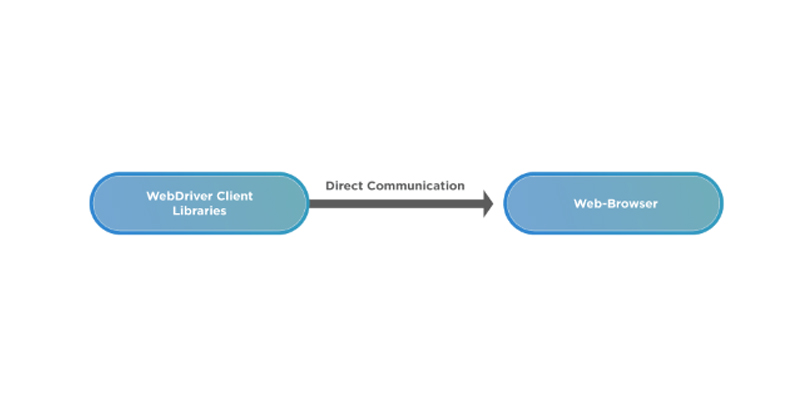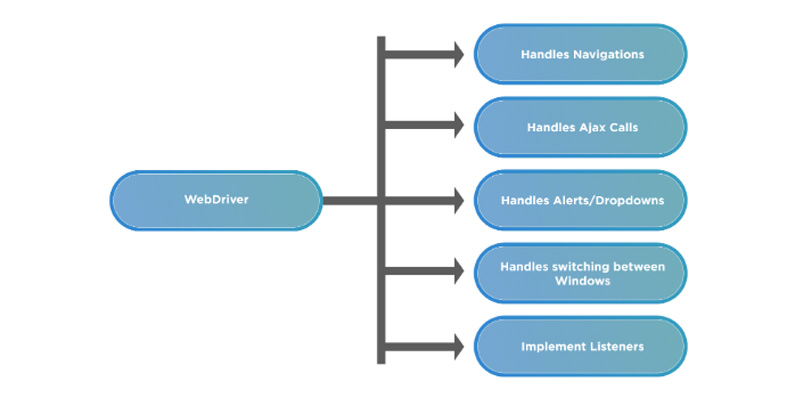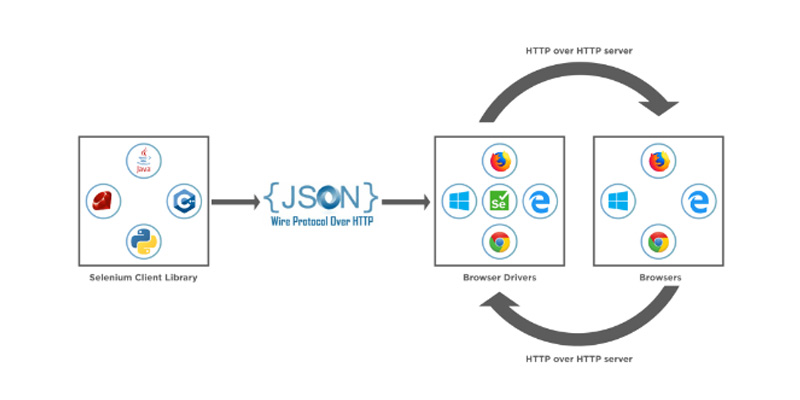Today, hundreds of web and mobile applications are being launched on the internet every day. The QA team must constantly be vigilant to ensure that these web applications are usable outside the development environment by ensuring the functionality of tested software before being made available to the client. The manual testers spent a lot of time performing this laborious task using their human power of observation.
Since selenium entered the market, it has had its flexible position in the automation industry. The Selenium toolkit, which includes the Selenium IDE, WebDriver, Selenium RC, and others, enables the QA team to simulate user actions on the web browser and automate the user flow, enabling the execution of numerous test cases quickly.
In this blog, we shall discuss what is webdriver in selenium, webdriver architecture and selenium framework architecture.
If you want to become a selenium automation tester, you can join the Selenium Course in Chennai and learn Selenium & Supported Languages – Java, C# & Python, OOPS concepts and core Java, Selenium IDE and RC and Selenium web driver.
What is WebDriver in Selenium and How does Selenium WebDriver work?
An open-source collection of APIs called Selenium WebDriver gives users the ability to communicate with any current web browser and subsequently automate user operations within that browser.
As we all know, Selenium is not a standalone tool; it is a group of tools that together make up the Selenium suite. This suite was produced as a result of the merger of the projects Selenium RC and WebDriver.
What are the Selenium Suits
- Selenium IDE
- Selenium RC
- Webdriver
- Selenium Grid
Why use Selenium WebDriver for Web Automation?
Now that we are clear on what Selenium WebDriver is and what it can do, it is imperative to evaluate why it is the best tool to utilise for web automation.
Dynamic Web Page Automation
Selenium WebDriver can automate dynamic websites where user activities modify the page content.
Multi-Browser Support
The Selenium community has been experimenting and working daily to create “one Selenium script for all browsers”. According to StatCounter, the most popular browsers globally are Chrome, Firefox, Safari, Internet Explorer, Opera, and Edge, and Selenium script is compatible with each of the browsers listed. You only need one script to work across all browsers, not several scripts for each.
Support for a Wide Range of Operating Systems
Your automation solution must support every operating system because different users use different ones. Despite this, Selenium is a very portable tool that operates and functions on a variety of operating systems, including Windows, Linux, Mac OS, UNIX, etc.
Supports Cross Browser Testing
When performing cross-browser testing, Selenium WebDriver has the biggest advantage because a QA can test the same website using the same piece of code on many browsers.
It enables the simultaneous validation and verification of test cases across several sets of browsers.
Supports Parallel Execution
By utilising frameworks like TestNG, Selenium WebDriver enables parallel execution. This enables the rapid execution of several test cases on a large scale.
Supports Modern Development Techniques
Through interaction with the Cucumber library, Selenium WebDriver works extremely well with contemporary software development ideas like behaviour-driven development.
If you intend to become a selenium automation tester, you can join the Selenium Course in Pondicherry and learn the basics to advanced concepts of selenium dits frameworks.
Why Selenium WebDriver is popular?
Being a member of the Selenium family, WebDriver includes some of the distinctive qualities that contribute to its appeal as a web automation tool in addition to the aforementioned features. Among them are the following:
Multi-Browser Compatibility
The ability to handle several browsers with the same piece of code in Selenium and WebDriver is one of the main factors for their popularity. By exploiting a browser’s built-in capability for direct API calls, it enables the execution of a specific piece of code that simulates a real-world user without the usage of any middleware software or hardware. A list of compatible browsers is shown below as an example:
- Chrome
- Firefox
- Safari
- Internet Explorer
- Opera
- Edge
Multi-Language Support
Not all testers have a strong command of a specific language.
Since Selenium supports a wide range of languages, a tester can utilise any of the supported languages and then automate using WebDriver. This allows programmers to develop code in a language they are familiar with.
Faster Execution
WebDriver doesn’t use a middleware server to interact with the browser, unlike Selenium RC. WebDriver communicates with browsers more quickly than most Selenium tools since it uses a predefined protocol (JSON Wire). Additionally, JSON Wire itself uses JSON, which is relatively lightweight, thus very little data is transferred during each call. The illustration below makes it crystal obvious how the WebDriver interacts with the browser:

Locating Web Elements
We must first decide which web element—such as a button, checkbox, drop-down menu, or textarea—needs action before we can click, type, drag, or drop it. WebDriver has methods to identify web elements using different HTML characteristics, such as identity, name, style, CSS, tag name, XPath, link text, etc., to make this easier.
Handling dynamic web elements
Sometimes a page will have web elements that will change as soon as you reload it.
Being able to recognise these items is difficult because HTML characteristics change. To address these problems, Selenium offers various techniques:
- Absolute Xpath -this includes the entire XML path of the element in question.
- Contains( ) – Using these functional elements, one can manage dynamic elements and do partial or full-text searches.
- Starts-With( ) – This function is based on locating elements using the attribute’s initial text.
If you want to become a python developer, or intend to get into the IT field, you must have proficient knowledge in any one programming language. So, if you are interested you can join a Python Training in Salem and learn the basic to advanced concepts of python.
Handling Waiting for Elements
Not every page has the same layout. Some are small and simple, while others handle a lot of data or use AJAX calls. The web elements frequently take a while to load. Due to this, WebDriver has created several waiting methods that can be used to pause the script’s execution for the necessary period in response to particular situations, and resume it after the condition has been fully met. An example set of WebDriver’s features, which aid in managing the dynamic behaviour of web pages mentioned below.
Web driver capability includes:
- Handles Navigations
- Handles Ajax calls
- Handles Alerts and dropdowns
- Handles switching between windows
- Execute Listeners
If you are looking for the various software-based courses, join the Training Institute in Chennai and learn multiple skills which help you get into IT companies.
What are the drawbacks of Selenium WebDriver?
The UI and functionality of web apps can be greatly improved by automating them with Selenium, but it has some drawbacks. In this section, we’ll look at some of the drawbacks:
Requires expertise and knowledge in programming
Anyone who desires to utilise WebDriver should understand a basic understanding of how to code in the programming language being used because it allows you to automate user behaviour using that language. It is challenging to use WebDriver if you don’t understand how to code in a programming language.
No assistance with desktop programmes
WebDriver and the Selenium ecosystem were created specifically for automating online applications. As a result, you will not be able to automate windows-based programmes.
No Customer Support
Because WebDriver is a component of the open-source Selenium ecosystem, neither individuals nor companies are in charge of its development. This puts you without committed team members to look into your issues. If one gets stuck, one can turn to any number of communities and forums.
No Built In Object Repository
Paid tools like UFT/QTP and its Object Repository offer a central location for storing objects/elements. This feature is not included by default in Selenium WebDriver. This can be avoided by employing strategies like the Page Object Model, but it necessitates a high level of technical knowledge.
Lack of built-in reporting
Selenium WebDriver can aid in the execution of your automated tests, but you should integrate it with a testing framework like Junit, TestNG, PyTest, Allure, etc., which will enable reporting capabilities.
Managing Browser-Selenium Dependencies
Because Selenium relies on compatibility between browser drivers and the actual browser, users must rely on community support to get problems fixed because functionality frequently fails due to inconsistencies or bugs in either the browser driver or the actual browser.
Understanding of Selenium WebDriver Architecture

This image provides information on the main Selenium components that make up WebDriver as well as the architecture of the core Selenium web driver.
Language Bindings for the Selenium WebDriver Client Libraries
Software testers should choose languages in which they feel at ease. There are bindings for a variety of languages, including Java, C#, Python, Ruby, PHP, etc., because the WebDriver Architecture supports several languages. Specific language bindings are available and can be used by anyone who has a basic understanding of how to work with any programming language. The Selenium Architecture gives testers the freedom to perform automation in their preferred style in this way.
If you want to learn java programing language, you can join a Java Training in Chennai and learn the core concepts of java like Data Types, Operators, Variables, Methods, Objects and Constructors.
JSON Wire Protocol
Based on the above Selenium Architecture, complete interaction between the code and the browser in Selenium is made possible by the JSON Wire Protocol. It is the heart of Selenium. The RESTful (Representational State Transfer) API, which offers a transport mechanism and specifies a RESTful web service using JSON over HTTP, provides a medium for data transfer utilising the JSON Wire Protocol.
Browser Drivers
Since Selenium supports a multitude of browsers, each browser has its version of the World wide web consortium standard that Selenium offers. To hide the execution logic from the customer, browser-specific binaries are provided. The client libraries and the browser binaries are connected using the JSONWire protocol.
Browsers
Only locally installed browsers, either on the local workstation or the server machines, will be allowed to execute tests on Selenium. It is, therefore, necessary to install a browser.
How does the Selenium WebDriver work?
The Selenium architecture was discussed in the section above. Let’s examine how interaction is handled behind the scenes. Look at the figure below to get a glimpse of how the workflow functions.

The following processes take place in the background when a user writes WebDriver code in Selenium and runs it:
- An HTTP request is sent to the appropriate browser driver (Chrome, IE, Firefox). Each Selenium command has its request.
- The request is delivered to the browser driver by an HTTP server.
- What commands or actions the browser needs to follow is decided by the HTTP server.
- The instructions/steps are carried out by the browser as previously decided.
- The automation script then displays the outcome after the HTTP server receives the execution status and delivers it back to it.
To have a comprehensive understanding of the Java programming language, you can join a Java Course in Bangalore and learn Strings, Java Beans – Arrays, Inheritance, Abstraction, Encapsulation – Interfaces and many others.
How to use Selenium WebDriver for Web Automation?
With the help of different browsers and Selenium WebDriver, automation is made incredibly easy, user-friendly, and coding-friendly. So all you have to do is configure Selenium to utilise the appropriate browser driver and browser.
The following five stages are typically included in every Selenium test script
- Set up a WebDriver instance customised for the browser
- Go to the web page you want to automate and navigate there
- On the website, look for an HTML element
- Perform an action on an HTML element
- Utilize a test framework to conduct tests and track their outcomes.
Now that you have understood what is web driver in selenium, selenium framework architecture and web driver architecture. So, to have a comprehensive understanding of selenium automation, you can join the Selenium Course in Bangalore and learn the core concepts of what is a web driver in selenium and web driver API in selenium and many other core concepts in detail.



